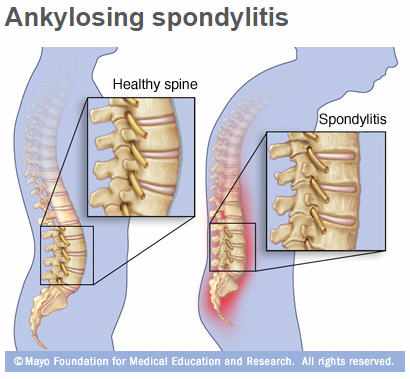-
Health & Wellness
Weekend Wellness: Ankylosing spondylitis symptom changes hard to predict
DEAR MAYO CLINIC: I’ve had ankylosing spondylitis for years, and could usually get relief by just taking over-the-counter pain medicine.  But lately the flares seem to be more frequent and painful. Is this common for the condition to worsen over time? What treatment should I try next, and is surgery ever effective for someone in my situation?
But lately the flares seem to be more frequent and painful. Is this common for the condition to worsen over time? What treatment should I try next, and is surgery ever effective for someone in my situation?
ANSWER: Symptoms of ankylosing spondylitis may get worse over time in some cases. But in others, they may improve with time or go away completely. These symptom changes often happen at irregular intervals, so they can be hard to predict. Medication typically is the most effective form of treatment. Most people with ankylosing spondylitis do not need surgery.
Ankylosing spondylitis is a disease that causes inflammation and leads to pain and stiffness. Many areas of the body can be affected by this disease. The most common include vertebrae in the lower back; the joints between the base of the spine and pelvis (called the sacroiliac joints); the hip and shoulder joints; and the cartilage between the breastbone and ribs. In some patients, the inflammation can affect other organs, including the eyes, leading to a condition called iritis or uveitis.
Ankylosing spondylitis may also cause symptoms in the places where your tendons and ligaments attach to bones. This is called enthesitis. It can occur in the spine, but sometimes it can also cause symptoms along the back of the heel resulting, for example, in Achilles tendonitis. In some cases, the inflammation caused by ankylosing spondylitis can cause vertebrae in your spine to fuse together, making the spine less flexible.
No cure currently exists for ankylosing spondylitis. But its symptoms often can be effectively managed with medication. The specific type of medication you need for your flare-ups depends on what part of your body they are affecting.
Flare-ups that cause stiffness and pain in your spine are a sign of active inflammation. When these symptoms are persistent, treatment usually involves medications known as TNF blockers. TNF stands for tumor necrosis factor — a cell protein that leads to inflammation. TNF blockers target this protein to help reduce pain, stiffness, and tender or swollen joints. Examples of these medications include adalimumab, etanercept and certolizumab. You receive TNF blockers via an injection under your skin or through an intravenous line.
If your flare-ups affect the joints of your arms and legs but not your spine, then the medications sulfasalazine or methotrexate can be helpful. However, these drugs generally do not help relieve inflammation in the spine.
Along with medication, physical therapy may help ease symptoms of ankylosing spondylitis. It can increase strength and flexibility, too. Ask your doctor about whether physical therapy may be useful in your situation. If so, your doctor may recommend you meet with a physical therapist who can show you exercises to fit your needs.
Surgery for ankylosing spondylitis is generally reserved for cases where the disease has caused significant damage to joints in the arms and legs. For example, if your hip joint becomes severely damaged as a result of this disease, then hip replacement surgery may be an option. Spine surgery is needed only in certain rare cases.
It is not uncommon to have fluctuations in the severity and frequency of ankylosing spondylitis symptoms over time. Talk to your doctor about the changes you have been experiencing recently. With his or her help, it is likely you can find treatment to effectively manage them. — Eric Matteson, M.D., Rheumatology, Mayo Clinic, Rochester, Minn.
Related Articles







